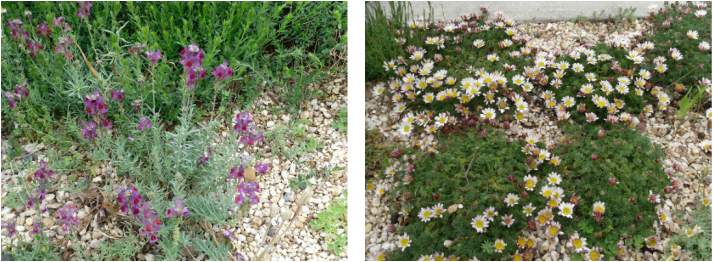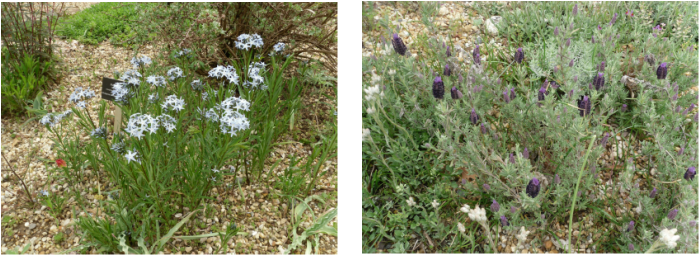|
by Dawn Szelc, LDG Secretary The May meeting for the Landscapes Designers Group was held on a beautiful morning at Green Spring Garden Park. Judy Zatsick met us in the library and provided some introduction to the park and to the topic of the morning which was rock gardening. Green Spring has a large rock garden in the circle outside the main building that was installed Donald Humphrey. Judy, a horticulturist at Green Spring, has become the caretaker for the rock garden as well as other areas at Green Spring. Her responsibilities include managing the propagation of a wide variety of plants from seeds and cuttings to be used in the gardens and for sale. She oversees the Garden Gate Plant Shop and is responsible for curating and designing the front gazebo and the glasshouse conservatory collection. Judy has a degree in Natural Resources from the University of Michigan. She pursued a career in commercial and fine art before finding her path in horticulture. She serves as the Vice President of the local chapter of the North American Rock Garden Society (NARGS). Judy discussed the history of rock gardening. It started in China and Japan and was brought first to England by affluent families who requested that their gardeners include them. It was then brought to the US in the early 1900’s, first in Massachusetts. Rock gardening is similar to perennial gardening but somewhat more difficult as the growing conditions are more stringent. It is best done on a small slope with a freely draining low organic mix soil. It is best to use locally sourced stone for a natural look and to use stone mulch around the plants. For our area that would include granite type stone and sandstone if available. Hypertufa containers, right below, are also often used and there was a class that morning at Green Spring on how to make your own. A north or east facing garden is best, while the garden at Green Spring is very hot in the summer with its location in the middle of the circular drive. The plants used within the garden are all alpine type plants and shrubs that are small and low growing.  Judy talked about numerous plants that do well in rock gardens: Phlox subulata, bulbs and small species tulips such as Turkestan clusiana, and Pulsitilla vulgaris. Plants with silver foliage and small leaves such as Penstamon x jonesii, Lavender Bandera purple. Dwarf species of amsonia, plumbago, lungwort, winecups, hypericum, and prickly pear which has a lovely yellow flower. There are also small shrubs that used such as potentilla, cotoneaster (flowing over the rock wall), and small conifers. Winter bloomers such as heaths and heathers are included as well as fall bloomers such as aster, chrysanthemum, Alaska daisy and fall bulbs.  Judy stated that moisture requirements are important to pay attention to for some plants. Some do need slightly more water than others. The rock garden at Green Spring does collect water from the pavement and parking in certain areas. When asked about sources for these types of plants she mentioned High Country Gardens and Plant Delights. She also said that it was better to look to xeric nursery sources than alpine nursery sources for our climate in Virginia.  Amsonia jonesii and Lavender "Bandera purple" Amsonia jonesii and Lavender "Bandera purple" .  Campanula "Blue waterfall" Campanula "Blue waterfall" We then walked out to see the garden. She explained that a rock wall feature like what was installed there was a key part of the garden. Many plants were growing in the crevasses of the wall. She also explained that although some of the shrubs had gotten overly large and were not appropriate for a rock garden she left them due to the high volume of visitors specially children who climbed through the garden. The shrubs restricted their ability to climb over everything. Judy pointed out additional plants of interest as we toured through the entire expanse – an unusual native Clematis, Walker’s Low Nepeta, Campanula “Blue waterfall”, Deutzia Niko Dwarf, Delasperma, and Aster “Snow Flurry” from North Creek Nursery among others.  Native Clematis Native Clematis There were so many things to see in every crack and crevice as well as every vantage point in the garden. As we wound up the conversation people continued to wander through the garden and point out another interesting plant or collection of rocks and plants. Thanks to Judy for providing an eye opening tour of the great potential of what can be done in rock gardens.
0 Comments
|
AuthorsLDG is a non-profit corporation dedicated to the exchange and enhancement of knowledge relevant to the landscape design profession. We are a group of professional designers in the metropolitan Washington, DC area. Membership is meant for students studying and professionals employed in landscape design or associated professions (i.e. arborists, installers, contractors, etc.). Archives
October 2023
CategoriesPast Newsletters can be found in the Members Only Section of the LDG Membership Connection. You must sign in to view these files.
Past Newsletters |
|
Search for a Landscape Designer in Your Area:
|

 RSS Feed
RSS Feed
